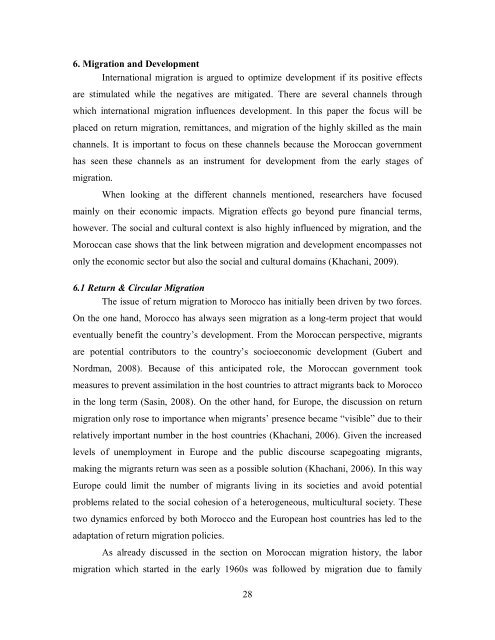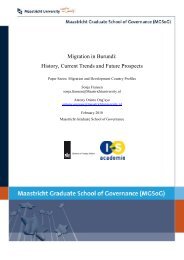Migration in Morocco: History, Current Trends and Future ... - MGSoG
Migration in Morocco: History, Current Trends and Future ... - MGSoG
Migration in Morocco: History, Current Trends and Future ... - MGSoG
Create successful ePaper yourself
Turn your PDF publications into a flip-book with our unique Google optimized e-Paper software.
6. <strong>Migration</strong> <strong>and</strong> Development<br />
International migration is argued to optimize development if its positive effects<br />
are stimulated while the negatives are mitigated. There are several channels through<br />
which <strong>in</strong>ternational migration <strong>in</strong>fluences development. In this paper the focus will be<br />
placed on return migration, remittances, <strong>and</strong> migration of the highly skilled as the ma<strong>in</strong><br />
channels. It is important to focus on these channels because the Moroccan government<br />
has seen these channels as an <strong>in</strong>strument for development from the early stages of<br />
migration.<br />
When look<strong>in</strong>g at the different channels mentioned, researchers have focused<br />
ma<strong>in</strong>ly on their economic impacts. <strong>Migration</strong> effects go beyond pure f<strong>in</strong>ancial terms,<br />
however. The social <strong>and</strong> cultural context is also highly <strong>in</strong>fluenced by migration, <strong>and</strong> the<br />
Moroccan case shows that the l<strong>in</strong>k between migration <strong>and</strong> development encompasses not<br />
only the economic sector but also the social <strong>and</strong> cultural doma<strong>in</strong>s (Khachani, 2009).<br />
6.1 Return & Circular <strong>Migration</strong><br />
The issue of return migration to <strong>Morocco</strong> has <strong>in</strong>itially been driven by two forces.<br />
On the one h<strong>and</strong>, <strong>Morocco</strong> has always seen migration as a long-term project that would<br />
eventually benefit the country’s development. From the Moroccan perspective, migrants<br />
are potential contributors to the country’s socioeconomic development (Gubert <strong>and</strong><br />
Nordman, 2008). Because of this anticipated role, the Moroccan government took<br />
measures to prevent assimilation <strong>in</strong> the host countries to attract migrants back to <strong>Morocco</strong><br />
<strong>in</strong> the long term (Sas<strong>in</strong>, 2008). On the other h<strong>and</strong>, for Europe, the discussion on return<br />
migration only rose to importance when migrants’ presence became “visible” due to their<br />
relatively important number <strong>in</strong> the host countries (Khachani, 2006). Given the <strong>in</strong>creased<br />
levels of unemployment <strong>in</strong> Europe <strong>and</strong> the public discourse scapegoat<strong>in</strong>g migrants,<br />
mak<strong>in</strong>g the migrants return was seen as a possible solution (Khachani, 2006). In this way<br />
Europe could limit the number of migrants liv<strong>in</strong>g <strong>in</strong> its societies <strong>and</strong> avoid potential<br />
problems related to the social cohesion of a heterogeneous, multicultural society. These<br />
two dynamics enforced by both <strong>Morocco</strong> <strong>and</strong> the European host countries has led to the<br />
adaptation of return migration policies.<br />
As already discussed <strong>in</strong> the section on Moroccan migration history, the labor<br />
migration which started <strong>in</strong> the early 1960s was followed by migration due to family<br />
28



